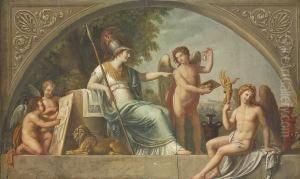Vincenzo Valdre Paintings
Vincenzo Valdre, also known as Vincenzo Valdrè or Ubaldo Gandolfi, was an Italian artist born in 1740 in Bologna. He was part of a family of artists, his father Mauro Gandolfi and his brother Gaetano Gandolfi were both painters. However, there is some confusion regarding his name and identity, as he is sometimes confused with Ubaldo Gandolfi, his uncle, who was a prominent painter of the same period. Despite this, Vincenzo established his own artistic identity and contributed to the Italian art scene of the 18th century.
Valdre initially trained under his father and uncle before he moved to Rome, where he was influenced by the classical and neoclassical movements that were popular during that time. His work often reflected the grandeur and idealism that characterized neoclassical art, and he was known for his attention to detail, his skillful use of light and shadow, and his ability to convey texture and form.
Though primarily a painter, Valdre was also a skilful draughtsman and architect. He spent most of his career in Italy, working on various commissions, including altarpieces and decorative schemes for churches and palaces. His works are characterized by a blend of the Baroque dynamism and the Neoclassical clarity and simplicity.
Later in life, Vincenzo Valdre's reputation grew beyond Italy, and he was invited to England where he worked on several significant projects. Notably, he became involved in the decoration of the Pantheon in Oxford Street, London, and contributed to the design of the Royal Pavilion in Brighton. His work in England represents an important part of his career and highlights the international appreciation for neoclassical art during this period.
Vincenzo Valdre died in 1814, leaving behind a legacy of work that is appreciated for its contribution to the transition between the Baroque and Neoclassical styles in Italian art. His pieces can be found in various collections and are studied for their historical as well as their aesthetic value.
